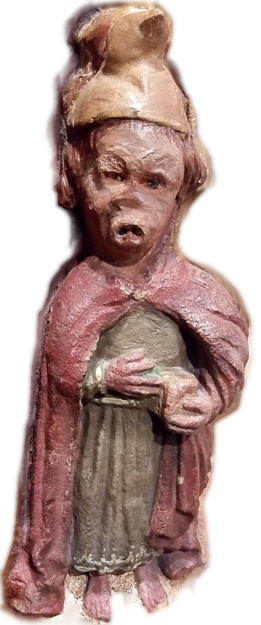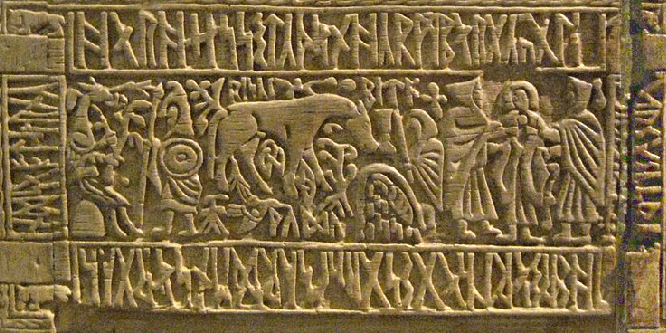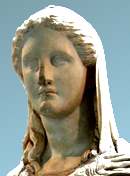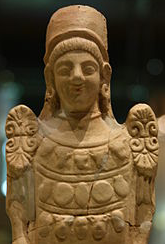7. Jews and Pigs have Things in common
Amusing discussions about Jews and pigs were often
typical for Christian meetings and banquets. During the Nazi era the
insult "Jewish sow" (Deutsch: Judensau) became popular in
Deutschland. While this is really a vicious insult, the
background of this talk was the fear that some Jews, who were often
especially puny, dark and ugly, were much misbehaving on the field of
public morale, sleeping around with blond girls and leaving them
behind pregnant. For the real God this was not a small problem. The
typical reaction of the Nazis was it at first to put such couples at
the pillory. They would take photos of them with texts defaming them
as Jewish swines and their sows. The problem was also that many
Eurasian Jews weren't really Hebrews, but Eastern-Turkish Chazars. At
first the Nazis only intended to deport all the Jews to new
homelands, including a new Israel. But when that plan failed, since
Britain had declared war, the plans came up to uproot the Jews. Due
to the total air war of the allied bombers it just became impossible
to feed all these detainees. Without doubt, the history of the Jews
still speaks against experiments of racial diversity today.
Plutarch, that great philosopher from Delphi, once
held a symposium discussing the question of what Jews deem about
pigs. Do they revere them or despise them? While these senior Greeks
were drinking watered wine, philosophising and cracking jokes, a guy
called Lamprias explained that his grandfather used to joke about
Jews all the time, since these refrained from consuming [certain
sorts of] meat. Lamprias found that seafood was indeed more
recommendable than the meat of terrestrial animals, because cattle
seemed to be closer related to us! Plutarch but had explained before
that meat was more difficult to digest. That was the reason why
physicians like Zeno or Krato consulted their patients to take in
seafood, as the lightest food, rather than meat. These guys were
really wise (Moralia 669). For the same reason the UTR recommends the
ovo-lacto-pescetarian Goddess Diet, a diet that recommends cold eggs,
milk and fish but no meat.
Now to the Jews. Pork is trejfe for them, it's a
forbidden food. So can it be that they dislike to eat pigs because
those are closer related to them? Indeed physicians say that the
inner organs of pigs are rather similar to those of humans. That
especially concerns the heart. But then again, it is their Bible that
demands of the Jews to do this or that or nothing. They believe that
God gets angry on them whenever they disobey to any commandments.
Woe, the religion of Moses is something for simple Semites, with a
tendency toward slavish obedience and bizarre legalism; who are far
away from sensing the wisdom, goodness and grace of God. Typical Jews
at least have a good tendency towards purity. Pigs are rather unclean
animals, and this should explain why Jews don't eat them. One aspect
of this discussion about pigs was the odd idea that pigs were
regarded as the teachers of agriculture! The idea has it that they
are rummaging through the soil, thus tilling it and making it become
more fruitful. In real life though, wild pigs would rather destroy
the gardens, fields and meadows that peasants were cultivating with
much effort. In his great book ›The White Goddess‹ and
others also Robert von Ranke-Graves discussed Jews in comparison to
pigs. Several times he mentioned the legend that some ancient
Egyptians were eating pork just once every year, exactly at midwinter
(solstice). So did the Jews also do this? There is no evidence at all
for such an idea.
Plutarch and his mates also discussed the religious
aspects of this Jewish food taboo. Can it be that impure things are
sacred too? Those philosophers evaluated all that they knew about the
Jews, which wasn't a lot. None of them had taken the time to
thoroughly investigate the religion of these murky dwarfs from the
Orient, that lately seemed to develop such a worrying spiritual sway.
Of course there was no proof to the idea that the Jews would hallow
swines. That rumour was rather born from the impulse to drive back
the upcoming new lores of the Jewish sects in the early years of the
Roman empire. Those heathens were losing their religion, and that
made them get angry on the Jews as well as the Christians, who were
moreless another Jewish sect. Indeed, if the Jews ever had had a holy
animal, then this must have been the donkey. They had been donkey
nomads in their early history, and still their cries like Hallelujah
remind of donkeys. The heathens then brought up more good reasons why
the pigs should be regarded as unclean and bad. Pigs were brought
into connection with leprosy. Then there was the legend that a boar
had killed the heathen deity Adonis. Adonis reminds of Adonai, a
Jewish name for the saviour. Likewise the Egyptian aardvark god Seth
had killed the saviour god Osiris. So really, there are reasons for
to think that the wild boar represented an adverse power, dangerous
to the saviour.
After writing about Jews and pigs, Plutarch turned
to the question of the god of the Jews. The wine-drinkers at his
dinner concluded that this must be another version of Dionysus, the
god of wine. Those heathens of the Orient had also taken Marcus
Antonius, the co-emperor of Augustus, for a living god of wine. But
the Jews were famous for not falling for such heathen superstitions.
The Jews indeed drank wine at certain religious occasions, but not as
much as the heathens often did. Those Greeks must have laughed when
it came out that the Jewish high priest wore the gown of a jester,
with little bells fixed to it who would jingle with every move. That
Jewboy would also even wear kothurns, high plateau sandals. But then
again, also Augustus occasionally wore these. Judging from their size
and looks, the Jews often sensed that they were not God's best
developed and wisest guys. Nevertheless, Judaism told them that they
were God's darlings. Therefore some wanted blond children, they tried
to racially upgrade, they wanted to be the blondest of the blond! In
ages past murky Jewish girls often wore blond wigs. Lately some
Israeli Jews, mostly of the very pious Ashkenazim (Europeans), have
grown natural colourful reddish hair and bright eyes.
The greatest English pop group of all time was The
Beatles, famous for their black mop top hair. ›Hey Jude‹
was one of their big hits. Lately Ms. Hillary Clinton sang this song
with Sir Paul McCartney at a fund raiser. But that performance didn't
"smash the crystal dome". In ancient Rome they maybe would
have sung of Julius Caesar, asking "the god" for help with
the presidential campaign. But who's Jude? The official legend has it
that Paul dedicated the song to Julian, the son of Mr. Lennon, but
later changed that name.
 Hey
Jude! So here you are in all your alien beauty! That bizarre statue
is the work of an anonymous Saxon master. In the Middle Ages such
images were common by-work of the artists who built the cathedrals.
By the way, one of my earliest ancestors was a second master at the
cathedral of St. Vitus in Prague. Often statues at the outside of the
churches or other buildings would display strange images of bizarre
animals, or even demons. Not rare were scenes of a ›Judensau‹
(Jewish sow). The scene typically showed a big sow together with some
Jews. The Jews would ride on that sow or fornicate with it, next to a
horned devil. A typical scene also shows Jews like piglets, drinking
from the mother sow's udders. The statue shown here is rather unique,
since it shows an alien as a man-like pig. But just that seems to be
the result of genial inspiration. When the artist of this relief
statue, in a church of St. Mary, thought of a Mary in the sky, he may
have received such a vision.
Hey
Jude! So here you are in all your alien beauty! That bizarre statue
is the work of an anonymous Saxon master. In the Middle Ages such
images were common by-work of the artists who built the cathedrals.
By the way, one of my earliest ancestors was a second master at the
cathedral of St. Vitus in Prague. Often statues at the outside of the
churches or other buildings would display strange images of bizarre
animals, or even demons. Not rare were scenes of a ›Judensau‹
(Jewish sow). The scene typically showed a big sow together with some
Jews. The Jews would ride on that sow or fornicate with it, next to a
horned devil. A typical scene also shows Jews like piglets, drinking
from the mother sow's udders. The statue shown here is rather unique,
since it shows an alien as a man-like pig. But just that seems to be
the result of genial inspiration. When the artist of this relief
statue, in a church of St. Mary, thought of a Mary in the sky, he may
have received such a vision.
Today such artwork is highly debated. Critics remind
of the fact that Walther Rathenau, a politician in the era of the
Weimar republic, was called a Judensau and shot dead by
right-wingers. That Jew had been among the architects of the
hyper-inflation, that ruined the finances of Deutschland after 1918.
We may take this as another scene from the perennial struggle between
the Jews and the Deutsche over who is really the chosen people of
this planet. While Christian right-wingers are still dangerous, it
surely helps now to decide this question for all time.
The UTR has it that only the Deutsche are truly the
chosen people of this planet. The Juden (Jews) are chosen by the
Feken goddess Fe-Juda. God had to use the help of these, to stop
invading Asian hordes. But only the truly chosen people can save this
earth.




 Beauty
is quite important when it comes to religion! But who is really
beautiful? That is a question to God the creator, the god who truly
has designed the human species. The problem is that such a creator
god is not really known to his world. The communication with such a
god is not really possible for humans. Most believers have the idea
that the god who created them was human, that this god is moreless
like they are. They but have diverse ideas about how God looks. That
is about to change as the creating deity performs a coming out. With
his or her face, God then tells what divine and human beauty is
supposed to be.
Beauty
is quite important when it comes to religion! But who is really
beautiful? That is a question to God the creator, the god who truly
has designed the human species. The problem is that such a creator
god is not really known to his world. The communication with such a
god is not really possible for humans. Most believers have the idea
that the god who created them was human, that this god is moreless
like they are. They but have diverse ideas about how God looks. That
is about to change as the creating deity performs a coming out. With
his or her face, God then tells what divine and human beauty is
supposed to be. This
older Demeter statue is archaic in style but also remarkably ugly.
The image comes, like some of my others, from the Wikipedia archive.
Some people try to earn money with such images. The Earth Goddess too
had the problem, that cults of her needed money to thrive. And did
you know that the first people who invented coins came from the lands
near to the Troas, the region of Troy? Some kings from Minor Asia are
famous for their wealth, for instance the legendary kings Midas and
Kroisos. Of the latter we know that he donated a hoard of gold to the
holy site of Delphi. He had been scared by an oracle that the god of
Delphi gave to him. In classical Greece that god was seen as the sun
god Apollon. But according to the UTR, Apollon had conquered Delphi
around the year of 1320 b. (also see the timetable of Paros). In
Delphi they said that Apollon had only conquered the seat and site of
Delphi from the Earth Goddess, who still gave oracles under the name
of Gê.
This
older Demeter statue is archaic in style but also remarkably ugly.
The image comes, like some of my others, from the Wikipedia archive.
Some people try to earn money with such images. The Earth Goddess too
had the problem, that cults of her needed money to thrive. And did
you know that the first people who invented coins came from the lands
near to the Troas, the region of Troy? Some kings from Minor Asia are
famous for their wealth, for instance the legendary kings Midas and
Kroisos. Of the latter we know that he donated a hoard of gold to the
holy site of Delphi. He had been scared by an oracle that the god of
Delphi gave to him. In classical Greece that god was seen as the sun
god Apollon. But according to the UTR, Apollon had conquered Delphi
around the year of 1320 b. (also see the timetable of Paros). In
Delphi they said that Apollon had only conquered the seat and site of
Delphi from the Earth Goddess, who still gave oracles under the name
of Gê. Hey
Jude! So here you are in all your alien beauty! That bizarre statue
is the work of an anonymous Saxon master. In the Middle Ages such
images were common by-work of the artists who built the cathedrals.
By the way, one of my earliest ancestors was a second master at the
cathedral of St. Vitus in Prague. Often statues at the outside of the
churches or other buildings would display strange images of bizarre
animals, or even demons. Not rare were scenes of a ›Judensau‹
(Jewish sow). The scene typically showed a big sow together with some
Jews. The Jews would ride on that sow or fornicate with it, next to a
horned devil. A typical scene also shows Jews like piglets, drinking
from the mother sow's udders. The statue shown here is rather unique,
since it shows an alien as a man-like pig. But just that seems to be
the result of genial inspiration. When the artist of this relief
statue, in a church of St. Mary, thought of a Mary in the sky, he may
have received such a vision.
Hey
Jude! So here you are in all your alien beauty! That bizarre statue
is the work of an anonymous Saxon master. In the Middle Ages such
images were common by-work of the artists who built the cathedrals.
By the way, one of my earliest ancestors was a second master at the
cathedral of St. Vitus in Prague. Often statues at the outside of the
churches or other buildings would display strange images of bizarre
animals, or even demons. Not rare were scenes of a ›Judensau‹
(Jewish sow). The scene typically showed a big sow together with some
Jews. The Jews would ride on that sow or fornicate with it, next to a
horned devil. A typical scene also shows Jews like piglets, drinking
from the mother sow's udders. The statue shown here is rather unique,
since it shows an alien as a man-like pig. But just that seems to be
the result of genial inspiration. When the artist of this relief
statue, in a church of St. Mary, thought of a Mary in the sky, he may
have received such a vision.